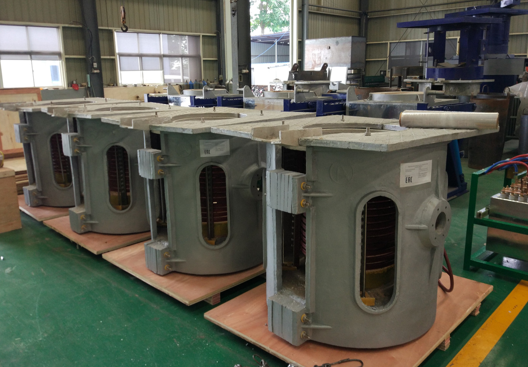Introduce several common induction furnaces
The principle of induction melting is that a high voltage power supply from the primary coil induces a low voltage, high current in the metal or secondary coil. Induction heating is just a method of transferring thermal energy.
Induction furnaces are ideal for melting and alloying a wide range of metals with minimal melt loss, but they are virtually impossible to refine. There are two main types of induction furnaces: coreless and channel.
Coreless Induction Furnace
The core of a coreless induction furnace is the coil, which consists of a hollow-section, heavy-duty, highly conductive copper tube that is wound into a helical coil.
The coil shape is contained within a steel case and magnetic shielding is used to protect the support case from heating. To keep it from overheating, the coil is water-cooled, and the water is recirculated and cooled in a cooling tower. The housing is supported on trunnions on which the stove is tilted for easy tipping.
The crucible is formed by tamping a granular refractory material between the coil and a hollow inner former that melts under the first heat, leaving a sintered lining.
The power cabinet converts the voltage and frequency of the mains, not the voltage and frequency required for electrofusion. The frequencies used in induction melting vary from 50 cycles per second (mains frequency) to 10,000 cycles per second (high frequency).
The higher the operating frequency, the greater the maximum power that can be applied to a furnace of a given capacity, and the lower the amount of induced turbulence.
As the charge melts, the interaction of the magnetic field and the current flowing in the induction coil creates a stirring effect within the molten metal. This stirring action forces the molten metal to rise upward in the center, creating a characteristic meniscus on the metal surface.
The degree of stirring is affected by the power and frequency applied as well as the size and shape of the coil and the density and viscosity of the molten metal. The stirring action in the molten pool is important because it helps in the mixing of the alloys and the melting of the turnings as well as the homogenization of the temperature throughout the furnace. Excessive agitation increases gas absorption, lining wear and alloy oxidation.
Coreless induction furnaces have largely replaced crucible furnaces, especially for melting high melting point alloys. Coreless induction furnaces are commonly used to melt all grades of steel and iron as well as many non-ferrous alloys.
The furnace is ideal for remelting and alloying due to the high degree of control over temperature and chemical composition, while the induced current provides good melt circulation.
Channel induction furnace
Channel induction furnaces consist of a refractory-lined steel shell that contains molten metal. Attached to the steel shell and through the throat is an induction unit that forms the melting part of the furnace.
The induction unit consists of a toroidal core around which the primary induction coil is wound. The assembly forms a simple transformer in which the molten metal loop includes secondary components.
The heat generated within the loop circulates the metal into the main shaft of the furnace. The circulation of the molten metal produces useful stirring in the melt.
Channel induction furnaces are often used for melting low melting point alloys, or as a holding and superheating device for high melting point alloys such as cast iron.
Channel induction furnaces can be used as supports for off-peak melting metal in coreless induction induction units, thereby reducing overall melting costs by avoiding peak demand charges.
We Hongteng mainly produce coreless induction furnaces. This kind of equipment runs stably and has high heating efficiency, which is very popular among users.
Welcome to Luoyang Hongteng, you can learn more about the induction furnace.
Video of the use process of the furnace


